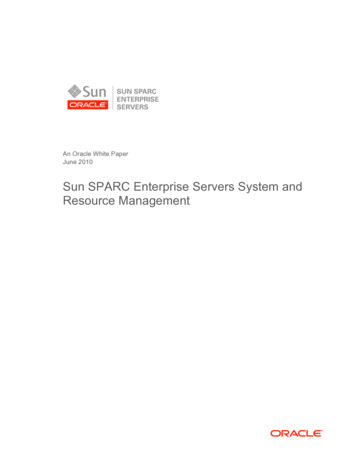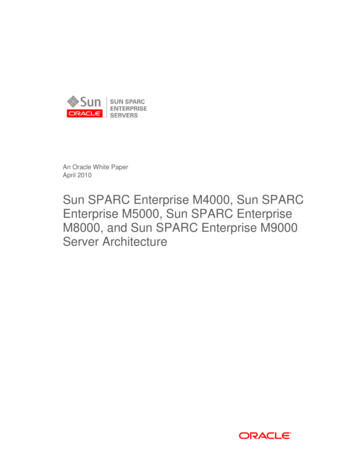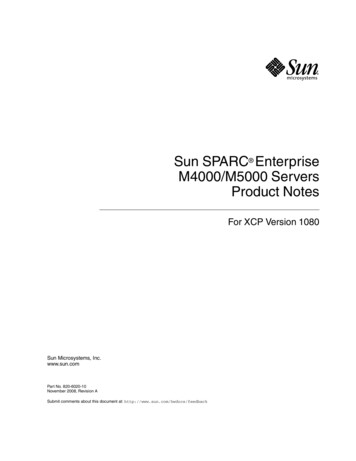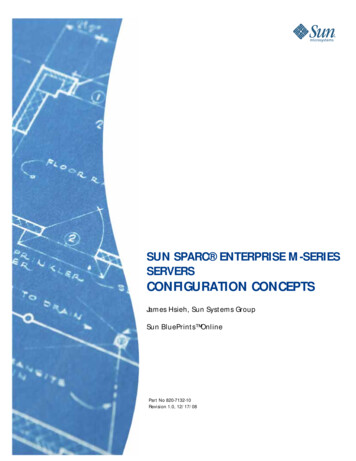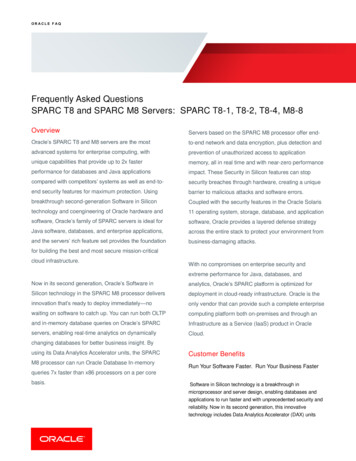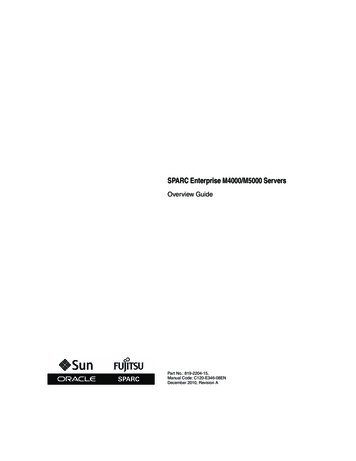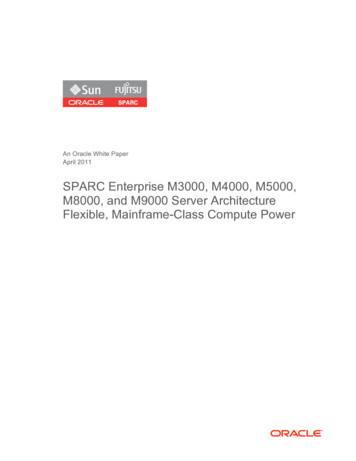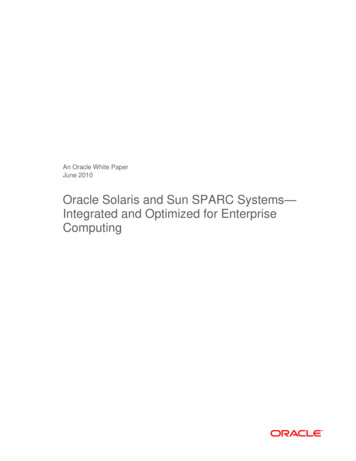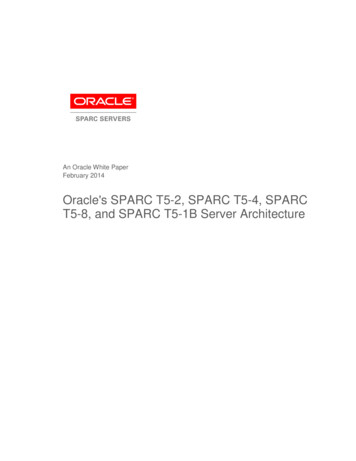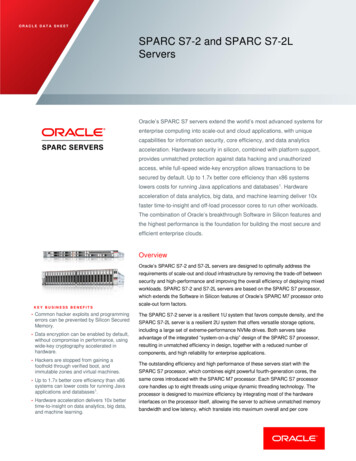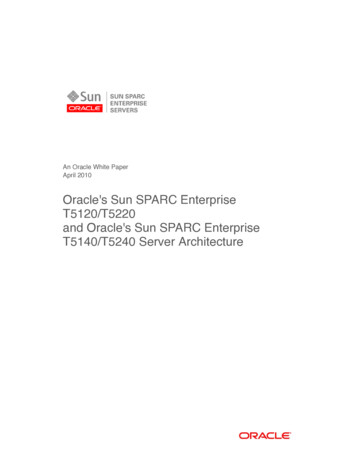
Transcription
An Oracle White PaperApril 2010Oracle's Sun SPARC EnterpriseT5120/T5220and Oracle's Sun SPARC EnterpriseT5140/T5240 Server Architecture
Oracle White Paper—Oracle's Sun SPARC Enterprise T5120/T5220 and Oracle's Sun SPARC Enterprise T5140/T5240 Server ArchitectureIntroduction.1The Evolution of Chip Multithreading.3Rule-Changing Chip Multithreading Technology.4Oracle's Sun SPARC Enterprise T5120/T5220 andOracle's Sun SPARC Enterprise T5140/T5240 Servers .7UltraSPARC T2 and T2 Plus Processors .15The World's First Massively Threaded Systems-on-a-Chip .15Taking Chip Multithreaded Design to the Next Level .17UltraSPARC T2 and UltraSPARC T2 Plus Processor Architecture.19Server Architecture .25System-Level Architecture .25Chassis Design Innovations .29Oracle's Sun SPARC Enterprise T5120 Server Overview .31Oracle's Sun SPARC Enterprise T5220 Server Overview .34Oracle's Sun SPARC Enterprise T5140 Server Overview .36Oracle's Sun SPARC Enterprise T5240 Server Overview .38PCI Express Expansion Unit .41Enterprise-Class Management and Software .43System Management Technology .44Scalability and Support for CoolThreads Technology .46Fault Management and Predictive Self-Healing .50Cool Tools: Performance and Rapid Time to Market .52Conclusion.54
Oracle White Paper—Oracle's Sun SPARC Enterprise T5120/T5220 and Oracle's Sun SPARC Enterprise T5140/T5240 Server Architecture
Oracle White Paper—Oracle's Sun SPARC Enterprise T5120/T5220 and Oracle's Sun SPARC Enterprise T5140/T5240 Server ArchitectureIntroductionServing the dynamic and growing data center IT services space is challenging for datacenter operations. Services need to be able to scale rapidly, often doubling capacity in ashort period even as they remain highly available. Infrastructure must keep up with theseenormous scalability demands, without generating additional administrative burden.Unfortunately, most data centers are already severely constrained by both real estate andpower—and energy costs are rising. There is also a new appreciation for the role that thedata center plays in reducing energy consumption and pollution. Virtualization hasemerged as an extremely important tool as organizations seek to consolidate redundantinfrastructure, simplify administration, and leverage underutilized systems. Security toohas never been more important, with the increasing price of data loss and corruption. Inaddressing these challenges, organizations can ill afford proprietary infrastructure thatimposes arbitrary limitations.Employing Oracleʼs UltraSPARC T2 and T2 Plus processors—the industryʼs firstmassively threaded systems-on-a-chip (SoC)— Oracle's Sun SPARC EnterpriseT5120/T5220 and Oracle's Sun SPARC Enterprise T5140/T5240 servers offerbreakthrough performance and energy efficiency to drive data center infrastructure andaddress other demanding data center challenges. Third-generation CoolThreads chipmultithreading (CMT) technology supports up to 128 threads in as little as one rack unit(1RU)—providing increased computational density while staying within variouslyconstrained envelopes of power and cooling. Very high levels of integration help reducelatency, lower costs, and improve security and reliability. Optimized system designprovides support for a wide range of IT services application types. Uniformity ofmanagement interfaces and adoption of standards help reduce administrative costs,while an innovative chassis design shared across Oracleʼs volume servers providesdensity, efficiency, and economy for modern data centers. With both the processor and1
Oracle White Paper—Oracle's Sun SPARC Enterprise T5120/T5220 and Oracle's Sun SPARC Enterprise T5140/T5240 Server ArchitectureOracle Solaris available under open source licensing, organizations are free to innovatewith a worldwide technical community.2
Oracle White Paper—Oracle's Sun SPARC Enterprise T5120/T5220 and Oracle's Sun SPARC Enterprise T5140/T5240 Server ArchitectureThe Evolution of Chip MultithreadingOracle’s UltraSPARC processors have led the industry for years—first, with the introduction ofmultithreaded, multicore chip design in the UltraSPARC T1 processor and now with the thirdgeneration UltraSPARC T2 Plus processor. By any measure, these first-generation CMTprocessors were an unprecedented success. Delivering up to five times the throughput in aquarter of the space and power, systems using these processors have rapidly been welcomed andaccepted. Now third-generation CMT technology is evolving rapidly to meet the constantlychanging demands of a wide range of enterprise data center applications.Business Challenges for Enterprise ApplicationsOrganizations across many industries hope to address larger markets, reduce costs, and gainbetter insights into their customers. At the same time, an increasingly broad array of wired andwireless client devices are bringing network computing into the everyday lives of millions ofpeople. This strong demand has a “pull-through” effect on the IT services that must be satisfiedin the data center. These trends are redefining data center scalability and capacity requirements,even as they collide with fundamental real estate, power, and cooling constraints. Driving data center virtualization and ecoefficiency. Coincident with the need to scaleservices, many data centers are recognizing the advantages of deploying fewer standardplatforms to run a mixture of commercial and technical workloads. This process involvesconsolidating underused and often sprawling server infrastructures with effective virtualizationsolutions that serve to enhance business agility, improve disaster recovery, and reduceoperating costs. This focus can help reduce energy costs and break through data centercapacity constraints by improving the amount of realized performance for each watt of powerthe data center consumes.Ecoefficiency provides tangible benefits, improving ecology by reducing the carbon footprintto meet legislative and corporate social responsibility goals, even as it improves the economyof the organization paying the electric bill. As systems are consolidated onto more dense andcapable computing infrastructure, demand for data center real estate is also reduced. Withcareful planning, this approach can also improve service uptime and reliability by reducinghardware failures resulting from excess heat load. Servers with high levels of standardreliability, availability, and serviceability (RAS) are now considered a requirement. Building out for Web-scale applications. Web-scale applications engender a new pace andurgency to infrastructure deployment. Organizations must accelerate time to market and timeto service, while delivering scalable high-quality and high-performance applications andservices. Many need to be able to start small with the ability to scale very quickly, with newcustomers and innovative new Web services often implying a doubling of capacity in monthsrather than years.3
Oracle White Paper—Oracle's Sun SPARC Enterprise T5120/T5220 and Oracle's Sun SPARC Enterprise T5140/T5240 Server ArchitectureAt the same time, organizations must reduce their environmental impact by working within thepower, cooling, and space available in their current data centers. Operational costs too arereceiving new scrutiny, along with system administrative costs that can account for up to 40percent of an IT budget. Simplicity and speed are paramount, giving organizations the abilityto respond quickly to dynamic business conditions. Organizations are also striving to eliminatevendor lock-in as they look to preserve previous, current, and future investments. Openplatforms built around open standards help provide maximum flexibility while reducing costsof both entry and exit. Securing the enterprise at speed. Organizations are increasingly interested in securing allcommunications with their customers and partners. Given the risks, end-to-end encryption isessential to inspire confidence in security and confidentiality. Encryption is also increasinglyimportant for storage, helping to secure stored and archived data even as it provides amechanism to detect tampering and data corruption.Unfortunately, the computational costs of increased encryption can increase the burden onalready overtaxed computational resources. Security also needs to take place at line speed,without introducing bottlenecks that can impact the customer experience or slow transactions.Solutions must help to ensure security and privacy for clients and bring business compliancefor the organization, all without impacting performance or increasing costs.Rule-Changing Chip Multithreading TechnologyAddressing these challenges has outstripped the capabilities of traditional processors andsystems, and required a fundamentally new approach.Mooreʼs Law and the Diminishing Returns of Traditional Processor DesignThe oft-quoted tenant of Moore’s law states that the number of transistors that will fit in asquare inch of integrated circuitry will approximately double every two years. For more thanthree decades the pace of Moore’s law has held, driving processor performance to new heights.Processor manufacturers have long exploited these gains in chip real estate to build increasinglycomplex processors, with instruction-level parallelism (ILP) as a goal. Today, these traditionalprocessors employ very high frequencies along with a variety of sophisticated tactics to acceleratea single instruction pipeline, including Large caches Superscalar designs Out-of-order execution Very high clock rates4
Oracle White Paper—Oracle's Sun SPARC Enterprise T5120/T5220 and Oracle's Sun SPARC Enterprise T5140/T5240 Server Architecture Deep pipelines Speculative prefetchesAlthough these techniques have produced faster processors with impressive-sounding multiplegigahertz frequencies, they have largely resulted in complex, hot, and power-hungry processorsthat are not well-suited to the types of workloads often found in modern data centers. In fact,many data center workloads are simply unable to take advantage of the hard-won ILP providedby these processors. Applications with high shared memory and high simultaneous user ortransaction counts are typically more focused on processing a large number of simultaneousthreads (thread-level parallelism, or TLP) rather than running a single thread as quickly aspossible (ILP).Making matters worse, the majority of ILP in existing applications has already been extracted,and further gains promise to be small. In addition, microprocessor frequency scaling itself hasleveled off because of microprocessor power issues. With higher clock speeds, each successiveprocessor generation has seemingly demanded more power than the last, and microprocessorfrequency scaling has leveled off in the 2 GHz to 3 GHz range as a result. Deploying pipelinedsuperscalar processors requires more power, limiting this approach by the fundamental ability tocool the processors.Chip Multiprocessing with Multicore ProcessorsTo address these issues, many in the microprocessor industry have used the transistor budgetprovided by Moore’s law to group two or more conventional processor cores on a single physicaldie—creating multicore processors, or chip multiprocessors (CMPs). The individual processorcores introduced by many CMP designs have no greater performance than previous singleprocessor chips, and in fact, have been observed to run single-threaded applications more slowlythan single-core processor versions. However, the aggregate chip performance increases sincemultiple programs (or multiple threads) can be accommodated in parallel (TLP).Unfortunately, most currently available chip multiprocessors simply replicate cores from existing(single-threaded) processor designs. This approach typically yields only slight improvements inaggregate performance since it ignores key performance issues such as memory speed andhardware thread context switching. As a result, although these designs provide some additionalthroughput and scalability, they can consume considerable power and generate significant heat—without a commensurate increase in overall performance.Chip Multithreading with CoolThreads TechnologyOracle engineers were early to recognize the disparity between processor speeds and memoryaccess rates. While processor speeds continue to double every two years, memory speeds havetypically doubled only every six years. As a result, memory latency now dominates muchapplication performance, erasing even very impressive gains in clock rates. This growing5
Oracle White Paper—Oracle's Sun SPARC Enterprise T5120/T5220 and Oracle's Sun SPARC Enterprise T5140/T5240 Server Architecturedisconnect is the result of memory suppliers focusing on density and cost as their design center,rather than speed.Unfortunately, this relative gap between processor and memory speeds leaves ultrafast processorsidle as much as 85 percent of the time, waiting for memory transactions to complete. Ironically,as traditional processor execution pipelines get faster and more complex, the effect of memorylatency grows—fast, expensive processors spend more cycles doing nothing. Worse still, idleprocessors often continue to draw power and generate heat. It is easy to see that frequency(gigahertz) is truly a misleading indicator of real performance.First introduced with the UltraSPARC T1 processor, CMT takes advantage of CMP advances,but adds a critical capability—the ability to scale with threads rather than frequency. Unliketraditional single-threaded processors and even most current multicore processors, hardwaremultithreaded processor cores allow rapid switching between active threads as other threads stallfor memory. Figure 1 illustrates the difference between CMP, fine-grained hardwaremultithreading (FG-MT), and CMT. The key to this approach is that each core in a CMTprocessor is designed to switch between multiple threads on each clock cycle. As a result, theprocessor’s execution pipeline remains active doing real useful work, even as memory operationsfor stalled threads continue in parallel.Figure 1. CMT combines CMP and fine-grained hardware multithreading.CMT provides real value since it increases the ability of the execution pipeline to do actual workon any given clock cycle. Use of the processor pipeline is greatly enhanced because a number ofexecution threads now share its resources. The negative effects of memory latency are effectivelymasked, because the processor and memory subsystems remain active in parallel to the processorexecution pipeline. Since these individual processor cores implement much-simpler pipelines thatfocus on scaling with threads rather than frequency (emphasizing TLP over ILP), they are alsosubstantially cooler and require significantly less electrical energy to operate. This innovativeapproach results in CoolThreads processor technology—multiple physical instruction execution6
Oracle White Paper—Oracle's Sun SPARC Enterprise T5120/T5220 and Oracle's Sun SPARC Enterprise T5140/T5240 Server Architecturepipelines (one for each core), with multiple active thread contexts per core. In addition,UltraSPARC T2 and UltraSPARC T2 Plus processors feature two execution pipelines per core tofurther boost scalability.The UltraSPARC T2 and T2 Plus ProcessorsUnlike complex single-threaded processors, CMT processors use the available transistor budgetto implement multiple hardware multithreaded processor cores on a chip die. The UltraSPARCT2 and UltraSPARC T2 Plus processors take the CMT model to the next level, providing up toeight cores per processor, with each core supporting up to eight threads via two independentpipelines—effectively doubling the throughput of the UltraSPARC T1 processor without raisingthe clock frequency. In addition, these processors use the increased transistor budget resultingfrom the use of a 65 nm silicon technology to implement the industry’s first massively threadedsystem–on-a-chip (SoC), with a single processor die hosting: Up to 64 threads per processor (up to eight cores supporting eight threads each) On-chip Level 1 and Level 2 caches Per-core floating-point capabilities Per-core cryptographic acceleration Two on-chip 10 Gigabit Ethernet (GbE) interfaces (UltraSPARC T2 processor only) On-chip PCI Express (PCIe) interface On-chip cache coherency logic and links (UltraSPARC T2 Plus processor only)Through SoC design, the UltraSPARC T2 processor significantly enhances the general-purposenature of the CPU—building in eight floating-point units (one per core). Enhanced floatingpoint capabilities open the UltraSPARC T2 to the world of compute-intensive applications aswell as the traditionally CMT-friendly data center throughput applications. No-cost security andcryptographic acceleration is provided by the on-chip, per-core streaming accelerators. Inaddition, the ability to move data in and out of the UltraSPARC T2 processor is significantlyaided by an integrated PCIe interface and dual 10 GbE interfaces on the UltraSPARC T2processor. The UltraSPARC T2 Plus processor replaces the dual 10 GbE interfaces with cachecoherency logic and links that facilitate a multisocket, glueless system designs.Oracle's Sun SPARC Enterprise T5120/T5220 andOracle's Sun SPARC Enterprise T5140/5240 ServersOracle's Sun SPARC Enterprise T5120/T5220 and Oracle's Sun SPARC EnterpriseT5140/T5240 servers (Figure 2) are all designed to leverage the considerable resources of theUltraSPARC T2 and UltraSPARC T2 Plus processors in the form of cost-effective, generalpurpose platforms. Oracle's Sun SPARC Enterprise T5120/T5220 servers deliver up to twice thethroughput of their predecessors, while leading competitors in terms of performance,7
Oracle White Paper—Oracle's Sun SPARC Enterprise T5120/T5220 and Oracle's Sun SPARC Enterprise T5140/T5240 Server Architectureperformance per watt, and SWaP performance (as evaluated by the Space, Watts, andPerformance metric detailed later in this section). Oracle's Sun SPARC Enterprise T5140/T5240servers extend this scalability by adding dual sockets for UltraSPARC T2 Plus processors andconsiderably large memory support. All these systems also extend the benefits of CMT frommultithreaded commercial workloads into technical workloads rich in floating-point operations.Figure 2. Oracle's Sun SPARC Enterprise T5120/T5220 and Oracle's Sun SPARC Enterprise T5140/T5240 servers are all designed toleverage the considerable resources of the UltraSPARC T2 and UltraSPARC T2 Plus processors.OverviewWith support for up to 128 threads, large memory, cryptographic acceleration, and integrated onchip I/O technology, these servers represent a departure from traditional system design. Oracle'sSun SPARC Enterprise T5120/T5140 servers are ideal for providing high throughput withinsignificant power, cooling, and space constraints. Oracle's Sun SPARC Enterprise T5120 serversupports a single UltraSPARC T2 processor whereas Oracle's Sun SPARC Enterprise T51408
Oracle White Paper—Oracle's Sun SPARC Enterprise T5120/T5220 and Oracle's Sun SPARC Enterprise T5140/T5240 Server Architecturesupports two UltraSPARC T2 Plus processors. Both systems feature a compact and powerefficient one rack unit (1RU) rack mount package. As compute nodes within massive,horizontally scaled environments, Oracle's Sun SPARC Enterprise T5120/T5140 servers can helpprovide a substantial building block for application tier, Web services, or even high-performancecomputing (HPC) infrastructure. Network infrastructure applications such as portal, directory,network identity, file service, and backup are all a good fit for these servers.Oracle's Sun SPARC Enterprise T5220/T5240 servers provide both throughput as well asexpandability, with extra I/O and internal disk options afforded by the 2RU rack mount formfactor. Oracle's Sun SPARC Enterprise T5220 servers support a single UltraSPARC T2 processorwhereas Oracle's Sun SPARC Enterprise T5240 servers support dual UltraSPARC T2 Plusprocessors. With greater I/O and internal disk, typical workloads include demanding midtierapplication server deployments or Web-tier and application-tier consolidation and virtualizationprojects requiring maximum uptime with future growth and integration into diverseenvironments. Oracle's Sun SPARC Enterprise T5220/T5240 servers are also ideal for onlinetransaction processing (OLTP) database deployments.Designed to complement each other, as well as the rest of Oracle’s server product line, Oracle'sSun SPARC Enterprise T5120/T5220 and Oracle's Sun SPARC Enterprise T5140/T5240 serversaddress the dynamic needs of the modern data center. Efficient and predictable scalability. With support for 64 threads and large memories,Oracle's Sun SPARC Enterprise T5120/T5220 servers are the first to use the 10 GbE, I/O,and cryptographic acceleration provided directly on the UltraSPARC T2 processor siliconitself. This approach provides leading levels of performance and scalability with extremely highlevels of power, heat, and space efficiency.Oracle's Sun SPARC Enterprise T5140/T5240 servers extend this breakthrough compute andmemory density, delivering up to 128 threads in as little as 1RU, while typically consuming lessthan 700 watts of power. These systems also deliver twice the I/O bandwidth of the SunSPARC T5120/T5220 servers by providing a PCIe root complex associated with each socket. Accelerated time to market. Oracle's Sun SPARC Enterprise T5120/T5220 and Oracle's SunSPARC Enterprise T5140/T5240 servers running Oracle Solaris provide full binarycompatibility with earlier UltraSPARC systems, preserving investments and rapid time tomarket. The CoolTools for SPARC help accelerate application selection, profiling, testing,tuning, debugging, and the deployment of key applications on CMT systems.Industry-leading tools for virtualization and consolidation. Oracle’s chip multithreading(CMT) technology is ideal for consolidation, providing low-level multithreading support forvirtualization at every layer of the technology stack. Oracle’s Virtual Machine for SPARC(OVMS) technology exploits the UltraSPARC T2 and UltraSPARC T2 Plus processor’s up to64 threads per socket, offering multiple guest operating system instances. In addition, OracleSolaris Containers provide virtualization within a single Oracle Solaris instance. The advanced9
Oracle White Paper—Oracle's Sun SPARC Enterprise T5120/T5220 and Oracle's Sun SPARC Enterprise T5140/T5240 Server ArchitectureOracle Solaris ZFS file system provides storage virtualization for storage and considerablescalability. System and data center reliability. Reliability is key to keeping applications available andcosts down. With the greater levels of integration provided by an SoC design, Oracle's SunSPARC Enterprise T5120/T5220 and Oracle's Sun SPARC Enterprise T5140/T5240 serversoffer greatly reduced part counts, and provide commensurately higher levels of reliability,availability, and serviceability (RAS). Lower power consumption and higher performance perwatt greatly reduce generated heat loads and the associated issues they cause. Technologiessuch as Solaris Predictive Self Healing are integrated with the hardware, and help keep systemsavailable.A tradition of leading ecoefficiency. Oracle's Sun SPARC Enterprise T1000 and Oracle'sSun SPARC Enterprise T2000 servers were the industry's first ecoresponsible servers. Oracle'sSun SPARC Enterprise T5120/T5220 and Oracle's Sun SPARC Enterprise T5140/T5240servers continue this tradition by offering the best performance and performance per wattacross a wide range of commercial and technical workloads. In addition, the UltraSPARC T2processor was the first processor to incorporate unique power management features at bothcore and memory levels of the processor.Zero-cost security. Providing secure communications and data protection has never beenmore important, with attempted electronic intrusion and theft at an all-time high. With up toeight integrated cryptographic accelerators on each UltraSPARC T2 and UltraSPARC T2 Plusprocessor, there is simply no need to send plain text on the network or store plain text instorage systems. Oracle's Sun SPARC Enterprise T5120/T5220 and Oracle's Sun SPARCEnterprise T5140/T5240 servers support many more crypto operations per second thancompetitive systems with dedicated crypto accelerator cards—all with minimal impact tosystem overhead.Simplified management. Each of Oracle's Sun SPARC Enterprise T5120/T5220 andOracle's Sun SPARC Enterprise T5140/T5240 server provides an Integrated Lights OutManager (ILOM) service processor, compatible with Oracle’s x64 servers. Integrated LightsOut Manager provides a command-line interface (CLI), a Web-based graphical user interface(GUI), and Intelligent Platform Management Interface (IPMI) functionality to aid with out-ofband monitoring and administration. Integrated Lights Out Manager also provides anAdvanced Lights Out Management (ALOM) backward-compatibility mode for administratorsfamiliar with Sun Fire and Oracle's Sun SPARC Enterprise T1000 and Oracle's Sun SPARCEnterprise T2000 servers.The industry’s most open platform. Oracle's Sun SPARC Enterprise servers are theindustry’s most open platforms, providing the only mainstream processor and hypervisoroffered under the GNU General Public License (GPL). These systems offer a choice ofoperating systems, including Oracle Solaris, Linux, and BSD variants. Oracle Solaris is free andopen, offering full binary compatibility and enterprise-class features.10
Oracle White Paper—Oracle's Sun SPARC Enterprise T5120/T5220 and Oracle's Sun SPARC Enterprise T5140/T5240 Server ArchitectureInnovative System DesignBeyond the capabilities of individual systems, Oracle understands that data centers have uniqueand pressing needs that require attention on the part of system designers. Density, performance,and scalability are all essential considerations, but systems must also be serviceable and fit in withmodern data center strategies that consider power, cooling, and serviceability. Oracle's SunSPARC Enterprise T5120/T5220 and Oracle's Sun SPARC Enterprise T5140/T5240 serversshare an innovative design philosophy that extends across Oracle’s volume x64 and SPARCserver platforms. Principles of this philosophy include Maximum compute density. Oracle’s volume servers provide leading density in terms ofCPU cores, memory, storage and I/O. This focus on density often lets Oracle’s 1RU rackmount servers replace competitive 2RU servers, for a 50 percent space savings.Continued investment protection. Oracle designs for maximum investment protection.Even with breakthrough technology such as chip multithreaded processors, applications simplyrun without modification.Leading storage capacity. Oracle’s volume servers provide leading density and flexibleRAID options. Smaller disk drives and innovations in structure, airway, and carrier design allowmore disk capacity in smaller spaces, while enhancing system airflow.Common, shared management. Oracle's Sun SPARC Enterprise T5120/T5220 and Oracle'sSun SPARC Enterprise T5140/T5240 servers are designed for ease of management andserviceability with service processors shared by other Oracle volume server platforms. Systemsand components are designed for easy identification, and hot-swap components facilitateonline replacement.Common chassis design. Shared chassis design leverages key system innovations acrossmultiple architectures, provides for common components and subassemblies, and greatlysimplifies administration for those deploying multiple processor architectures.Table 1 compares Oracle's Sun SPARC Enterprise T5120/T5220 and Oracle's Sun SPARCEnterprise T5140/T5240 servers.11
Oracle White Paper—Oracle's Sun SPARC Enterprise T5120/T5220 and Oracle's Sun SPARC Enterprise T5140/T5240 Server ArchitectureTABLE 1. ORACLE'S SUN SPARC ENTERPRISE T5120/T5220 AND ORACLE'S SUN SPARC ENTERPRISE T5140/T5240 SERVERFEATURESFEATUREORACLE'S SUN SPARCORACLE'S SUN SPARCORACLE'S SUN SPARCORACLE'S SUN SPARCENTERPRISE T5120ENTERPRISE T5220ENTERPRISE T5140ENTERPRISE T5240SERVERSERVERSERVERSERVERFour-core or eight-coreFour-core or eight-coreDual four-, six-, orDual four-, six-, or eight-1.2 GHz or eight-core1.2 GHz or eight-coreeight-core 1.2 GHz orcore 1.2 GHz or eight-1.4 GHz or 1.6 GHz1.4 GHz or 1.6 GHzeight-core 1.4 GHzcore 1.4 GHz or 1.6UltraSPARC T2UltraSPARC T2UltraSPARC T2 PlusGHz UltraSPARC T2processorprocessorprocessorsPlus processors1ThreadsUp to 64Up to 64Up to 128Up to 128MemoryUp to 128 GB (2 GB, 4Up to 128 GB (2 GB, 4Up to 128 GB (2 GB,Up to 128 GB (2 GB, 4capacityGB, or 8 GB FB-GB, or 8 GB FB-4 GB, or 8 GB FB-GB, or 8 GB FB-DIMMs)DIMMs)DIMMs)DIMMs)2MaximumUp to eight SFF 2.5-Up to 16 SFF SAS 2.5-Up to eight SFF 2.5-Up to 16 SFF 2.5-inchinternal diskinch SAS 73 GB, 146inch SAS 73
Oracle White Paper—Oracle's Sun SPARC Enterprise T5120/T5220 and Oracle's Sun SPARC Enterprise T5140/T5240 Server Architecture The Evolution of Chip Multithreading Oracle's UltraSPARC processors have led the industry for years—first, with the introduction of
